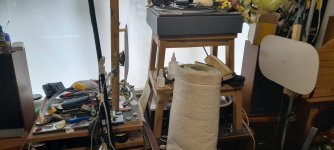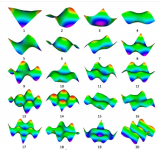I have read through a bunch of patents, but admittedly skimmed through many of them not being able to follow them really 🙂 But cannot recall seeing any mention of rounded corners. You don't happen to know which patents?Leob.
There are patents describing the use of rounding the corners and why.
But I must admit I have never really heard much difference in sound?
I do round my small card panels though as this stops the corners flapping around uncontrollably.
Steve.
Rounding corner is useful on free hanging. But not necessary. Depends on the panel have resonances on the corners or not. Most but not all my panels has it when play loud. Round the corners resonances gone. So I think it's useful by case.I'm sceptical if rounding the corners is useful at all. If will affect the modes a bit like any modification of the plate, but since you anyway need to adjust dimensions and clamping to get a smooth FR, I don't see the point of bringing in an extra variable.
So far I have only seen tech ingredients video suggesting it is useful, but without any real data to prove it.
That makes sense, although I wonder if not moving the resonances away from the corners by altering dimensions might be better in those cases, or at least achieve the same result.
Leob.
The patent with all the different shapes and measurements, I have lost and cannot find again ☹️
By the time I find the patent with the rounding or cutting corners of different shapes and angles, hopefully someone else would have found them first😀
Steve.
The patent with all the different shapes and measurements, I have lost and cannot find again ☹️
By the time I find the patent with the rounding or cutting corners of different shapes and angles, hopefully someone else would have found them first😀
Steve.
Could bass shakers (buttkickers) serve as DML-sub driver on a larger stiff panel? Anybody that tried? 🤔
Wilbur-x.
If I had a spare buttkicker I would most definitely first try attaching one to my stud wall, and turn the whole wall into a low frequency driver.
When I attached my hdn8 to the stud beam I had a full range wall panel😁 with plenty of bass.
I think it went down to about 40hz ?
Steve.
If I had a spare buttkicker I would most definitely first try attaching one to my stud wall, and turn the whole wall into a low frequency driver.
When I attached my hdn8 to the stud beam I had a full range wall panel😁 with plenty of bass.
I think it went down to about 40hz ?
Steve.
I bought 2 Dayton pucks for that reason.Could bass shakers (buttkickers) serve as DML-sub driver on a larger stiff panel? Anybody that tried? 🤔
Unfortunately I found them to be useless. Shake the panel to bits and virtually no output.terrible dynamics...I then cut one open and tried a direct attachment of the magnet to the panel and braced the coil..still useless
Packed them away..
.Maybe it's just me..🤔
Last edited:
Actually, it might be interesting to try my hdn8 on the stud wall and compare it to my TLS and other LF speakers.
And maybe XO to my small panels.
It's a thought, you don't know until you try 🤗
Steve.
And maybe XO to my small panels.
It's a thought, you don't know until you try 🤗
Steve.
i recorded this the other day but did not get around to posting it.
it is still my card panels but i have propped the phone up on a rolled up rug.
i have been listening to this in the car and decided it was so good i had to record it.
two clips from the armed man : A mass for peace.
steve
it is still my card panels but i have propped the phone up on a rolled up rug.
i have been listening to this in the car and decided it was so good i had to record it.
two clips from the armed man : A mass for peace.
steve
Attachments
Leob, Hkguy,That makes sense, although I wonder if not moving the resonances away from the corners by altering dimensions might be better in those cases, or at least achieve the same result.
I am pretty certain that any free hanging panel will have "resonances" at the corners, no matter what the dimensions.
I put "resonances" in quotes because technically resonances really don't occur at a particular place on a panel, but rather involve the whole panel. What I think you really mean is that for a free hanging panel, the corners will be antinodes (locations of maximum displacement) for certain resonant frequencies. In other words, the corners will tend to flap around wildly at certain frequencies. And that of course is true. In fact, for a free hanging panel, the corners will be antinodes for virtually every resonant frequency, not just a few.
Attached are typical mode shapes for a free hanging panel with square corners (first), for rounded corners (second).
In both, the corners will tend to flap, but with the rounded corners displacement amplitude (flapping) should be mitigated.
In most cases, I suspect the worst of the flapping comes from the fundamental, for which the mode shape typically looks like the third image. And often, this mode occurs at some low/inaudible frequency (i.e. below 20 Hz), so the flapping is all totally useless. So it makes sense for such panels to roll them off (i.e. use a high pass filter) to keep the lowest frequencies from reaching them, as Spedge often suggests.
Eric
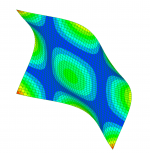
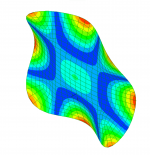
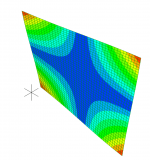
In my search for patents I came across this in my list from 2016.
It mentions impulse response(page4) and microphone measurements for dml(page 6) and much more.
I did find some other patents that mention impulse response, but they all say the same.
Steve.
https://simeoncanada.com/wp-content/uploads/2018/12/NXT-Technology-Review.pdf
It mentions impulse response(page4) and microphone measurements for dml(page 6) and much more.
I did find some other patents that mention impulse response, but they all say the same.
Steve.
https://simeoncanada.com/wp-content/uploads/2018/12/NXT-Technology-Review.pdf
Would you believe it, I just found this patent from 1969 !
https://patents.google.com/patent/US3636281A/en
Steve.
https://patents.google.com/patent/US3636281A/en
Steve.
That might be the most comprehensive summary of NXT technology that I've ever seen. Thanks for that link.In my search for patents I came across this in my list from 2016.
It mentions impulse response(page4) and microphone measurements for dml(page 6) and much more.
I did find some other patents that mention impulse response, but they all say the same.
Steve.
https://simeoncanada.com/wp-content/uploads/2018/12/NXT-Technology-Review.pdf
Eric
ps, I actually have a small collection of the Armstrong ceiling tile speakers shown in Fig 29 of that article. Some friends of mine actually developed that product for Armstrong. Sadly, none of them were much involved with the acoustical aspects of the product. Apparently consultants did that part.
Hi Steve;Alaska129.
Sanding large eps panels is a pain in the neck , and it is easy to accidentally score a groove into the material, if rushed.
You could sand the panel and only coat the panel an inch or two around the exciter, to hear how it sounds without the skin, similar to tech ingredients, I have an uncoated eps panel still lying around from years ago for comparisons.
The sanded surface will have a soft and fluffy feel ,and sounds a little soft too, tech ingredients seem to like this and say it acts as a sound absorber?
Just thought you might like to experience this first ?
Are you thinking of using the panel full range, or using a low frequency driver for support ?
Which exciter model are you using?
A fairly fine sand paper should be OK, you don't want to go too deep, it's more like scuffing the surface to get that fluffy feel.
The very thinned pva will just soak into the fluffy surface ,producing a better sounding hard skin, pva will take a couple of days to fully harden for full HF performance.
I use the nxt recomended 4/9 x 3/7 exciter positions myself ,for a more central position .
Steve.
I will probably sand my panel and use a pva coating, if they turn out ok. Tech ingredients while interesting videos are no where near the level of those in this thread. Personal observation. While Leob's hide glue and shellac sounds interesting and I think a harder surface. It's been a long time since I’ve been setup with a hot glue pot or alcohol and shellac. While this thread is full range, I will probably use a cap ( ya I’m cheap too) as a HPF and roll off below 160 to 200 hz. I have LF drivers to fill in. As for the drivers … the DAEX25FHE-4 seems popular in the 24 watt range ( lighter more efficient? ) while others especially on YouTube seem to favor the 40 Watt, thrusters etc. I would think with EPS even the 24 W driver on a large panel would be more then sufficient at non outdoor Pa volumes. Thank you for the NXT 4/9 3/7 positions. Another thing to add to the mix 😉
Last edited:
Alaska129.
My single 10watt exciter on an EPS panel is enough to annoy the neighbours and cause serious hearing problems.
The 24watt seems a good choice though and hopefully not too heavy.
I usually use a pretty steep roll off around about 100hz depending on panel type, but I would recommend running the low frequency driver up to 300hz to sort out room suck out problems, if you have them ?
Can you measure your room response and panel ?I
NXT give up to 4 exciter positions which are different from tectonic, but tectonic use a ring on a green sub frame ,but I am not sure how the sub frame is connected to the panel?
The panel animation I have seen , seems to show two mounting points or two exciters ?
Tectonic don't give much away and have removed certain drawings that I mentioned, that Eric posted some time ago , coincidence or not ?
I am about to read the tectonic patent Eric posted some time ago too, but I'm not expecting much enlightenment about what is actually going on on their PA panels.
We shall see.
Steve.
My single 10watt exciter on an EPS panel is enough to annoy the neighbours and cause serious hearing problems.
The 24watt seems a good choice though and hopefully not too heavy.
I usually use a pretty steep roll off around about 100hz depending on panel type, but I would recommend running the low frequency driver up to 300hz to sort out room suck out problems, if you have them ?
Can you measure your room response and panel ?I
NXT give up to 4 exciter positions which are different from tectonic, but tectonic use a ring on a green sub frame ,but I am not sure how the sub frame is connected to the panel?
The panel animation I have seen , seems to show two mounting points or two exciters ?
Tectonic don't give much away and have removed certain drawings that I mentioned, that Eric posted some time ago , coincidence or not ?
I am about to read the tectonic patent Eric posted some time ago too, but I'm not expecting much enlightenment about what is actually going on on their PA panels.
We shall see.
Steve.
I have used the DAEX25FHE-4, DAEX30HESF-4 and some big 50w exciters I got from alibaba.Hi Steve;
I will probably sand my panel and use a pva coating, if they turn out ok. Tech ingredients while interesting videos are no where near the level of those in this thread. Personal observation. While Leob's hide glue and shellac sounds interesting and I think a harder surface. It's been a long time since I’ve been setup with a hot glue pot or alcohol and shellac. While this thread is full range, I will probably use a cap ( ya I’m cheap too) as a HPF and roll off below 160 to 200 hz. I have LF drivers to fill in. As for the drivers … the DAEX25FHE-4 seems popular in the 24 watt range ( lighter more efficient? ) while others especially on YouTube seem to favor the 40 Watt, thrusters etc. I would think with EPS even the 24 W driver on a large panel would be more then sufficient at non outdoor Pa volumes. Thank you for the NXT 4/9 3/7 positions. Another thing to add to the mix 😉
Since I was rushing to get the system ready in time I didn't have time to analyse the difference between them really. The 50w exciters probably behave similar to many thrusters, and will lack treble for a full range application.
My impression is that the DAEX30HESF-4 is the better exciter compared to DAEX25FHE-4. Of course I needed the extra power, but also got the impression that both response and sensitivity was better, but I need to test them on identical panels to be sure.
What is sufficient when it comes to power is very individual. Also keep in mind that for perceived doubling of volume you need 10x the power. Two panels with a single 24w exciter each would not be enough for me for home use, but then I'm probably damaged 🙂
But even with 4x 40w per panel it is not double the volume of a single 24w, so you quickly get to a point of diminishing returns to get those extra dB if you want it really loud.
Leob.
My 10watt exciters do not heat up when properly XOd when playing very loud music.
But is always a good idea to have a bit of headroom to prevent the overheating of the coils.
I find it hard to believe Alaska129 will need more volume from his EPS panels in a domestic environment .
The problem is usually having a low frequency driver that can keep up with the panels.
Steve.
My 10watt exciters do not heat up when properly XOd when playing very loud music.
But is always a good idea to have a bit of headroom to prevent the overheating of the coils.
I find it hard to believe Alaska129 will need more volume from his EPS panels in a domestic environment .
The problem is usually having a low frequency driver that can keep up with the panels.
Steve.
- Home
- Loudspeakers
- Full Range
- A Study of DMLs as a Full Range Speaker
